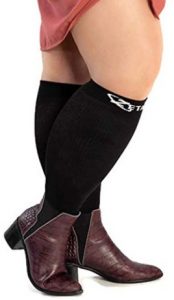
If you’ve searched for XXL compression socks in the past, you may have been disappointed by a minimal selection with even fewer style options. Don’t spend another moment with ugly socks on your feet!
Buy XXL Compression Socks HERE:
How do you know the right size and length socks for you? Whether you are a first-time buyer or an old pro, this simple guide will help you find your perfect pair.
How Can Compression Socks Help Me?
Benefits of Compression Socks Include:
- Improved Circulation and Vein Health
- Treatment and Prevention of Deep Vein Thrombosis (DVT) and Varicose Veins
- Treatment and Prevention of Swelling in the Legs and Feet
- Relief for Plantar Fasciitis
- Care for Diabetic Neuropathy

DVT
DVT stands for deep vein thrombosis. This phenomenon occurs when a clot forms in the deep veins of your legs.
Sometimes, the clot can dislodge and travel upwards to the lungs, causing a pulmonary embolism (PE).
As reported on the Centers for Disease Control and Prevention website, about 900,000 Americans suffer from DVT.
ComproGear Medical Socks offer 20 to 30 mmHg of pressure to relieve DVT symptoms and support tired legs.
Common Symptoms of DVT:
- Swelling
- Pain
- Skin Discoloration
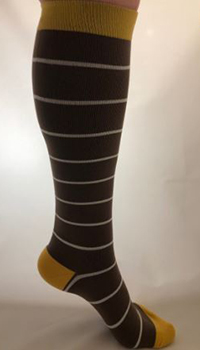
Many people who have DVT don’t know it because they don’t perceive the symptoms until it’s too late. They may also develop DVT because of travel long distances or because they are at higher risk because of occupational/environmental factors.
For instance, people over the age of 40 tend to develop more clots than younger people.
Specific medical conditions, such as congestive heart failure, hypercoagulability, and inflammatory bowel disease, also increase your risk of DVT.
Worse yet, if you’ve had it once, you have a high risk of getting it again. To avoid a recurrence, those who recovered once from DVT may make wearing ComproGear hosiery a part of their daily routine.
Staying active also helps, especially walking or exercising your calves. Always contact a medical professional before starting any exercise regimen or wearing medical-grade compression socks.
Varicose Veins
Though some people with varicose veins don’t seem to experience any symptoms, others describe a feeling of heaviness, tiredness, severe shaking, throbbing, or a burning or itching sensation in their legs.
The discomfort of varicose veins can affect how you work and how you engage in physical activities.
Compression therapy, aided by 20 to 30 mmHg grade medical socks, helps control swelling and may slow the progression of lower extremity varicose veins. Apart from wearing knee- or thigh-high socks, you should consider taking frequent breaks to rest your legs after extended periods of sitting or standing.
Does Size Matter?
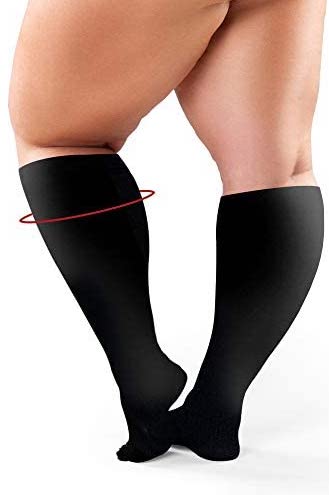
Finding the right size compression sock is a common issue. After all, people don’t have to pay the same amount of attention to their regular sock size.
But medical and compression socks are different. The fit of therapeutic hosiery is especially important because it affects the intensity of the compression. This gentle squeeze is the source of all of their benefits.
Thankfully, extra-large socks and stockings are available for those who need plus sizes. Sizing also varies from company to company. So, even if your current socks are XXL, you can’t assume that you will wear the same size medical socks.
Unfortunately, you can’t just eyeball them either to determine the size since most medical hoses look smaller than their actual size.
Compression socks should fit tightly in the ankle and slightly looser as they go up the calf. The stretchy, elastic material is designed to stretch during use and afterward return to its original size.
How Do I Select the Right Socks?
- Take measurements of both legs (they may differ).
- Compare your measurements with the sizing guide.
- Check if your required pressure level is available in the recommended size.
- Decide which length and style you prefer.
Let’s look at each step in detail:
How to Measure Yourself for Compression Socks and Sleeves?
To get the perfect fit, you’ll need to take the accurate measurements of your legs. The areas you’ll need to measure will vary accordingly with the length ( knee-high, thigh-high, full-length, etc.) and style of medical compression footwear you intend to buy.
Knee-high Medical Socks and Stockings:
- For knee-high compression socks and stockings, you need to measure your feet, thighs, ankles, and calves.
- Measure your ankles correctly by taking the distance from the smallest to the thickest area of your calves.
- Plant your feet flat and record the distance from the soles of your feet to the top of your knees.
- To obtain the most accurate measurements, enlist the help of someone else while you stand with your legs straight.
Thigh-high Medical Socks and Stockings:
- For thigh-high medical socks and stockings, you need to measure not only the distance from the soles of your feet to your thighs but also the circumference of your thighs.
- A ribbon-style measuring tape works well for these types of measurements.
Full-length Medical Socks and Stockings:
- For full-length medical pantyhose and socks, you need to measure the circumference of the fullest part of your hips.
- Also, take measurements of the distance from your feet to your hips.
How Do I Know the Right Compression Level to Purchase?

Apart from the size, there’s another crucial detail to consider when it comes to choosing your medical socks: Compression Level!
The level of pressure necessary depends on what you are trying to accomplish. For instance, if you need them for everyday swelling, a low-pressure level will suit your purposes.
However, if you are using medical socks to relieve the symptoms of medical conditions, such as varicose and spider veins, opt for socks with higher pressure levels.
Compression levels are measured using mmHg—the same scale used to measure blood pressure. Several different compression levels are available, varying from 8 to 50 mmHg.
You can use medical socks with 8-15 mmHg for minimal support. Socks with compression levels of 15-20 mmHg are on the market for those who need stronger support. This compression level is perfect for sports, travel, pregnancy, or even just another day at the office.
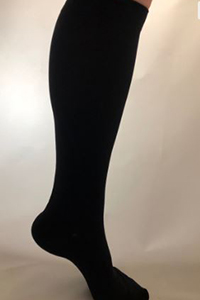
The 20-30 mmHg option offers firm compression and is often recommended to patients after surgery to promote faster recovery. This compression levels aids in preventing pain and swelling. This is also the most common compression level used.
You might need to get a prescription if you need compression levels over 30 mmHg. Higher compression levels of 30-50 mmHg are intended for the use by patients with serious medical conditions, such as deep vein thrombosis (DVT) and edema.
The exact duration you should wear your socks each day should be based on the advice of a physician who has a proper understanding of each compression level. Your doctor will help you to choose the compression level that aligns with your specific needs and purposes.
How Do I Know the Right Length and Type to Buy?

As mentioned previously, there are several different lengths of medical hosiery and socks. These include knee-high, thigh-high, waist-high, and sleeves. Before selecting your compression socks, determine which area of your legs need the most pressure.
If you frequently suffer from swelling below the knee, knee-high medical footwear is your best choice. This length will apply the ideal amount of pressure on your feet, ankles, and calves to bring down the swelling. They’re also helpful for mediating moderate cases of varicose and spider veins. Knee-high medical socks are the most popular length of compression socks.
However, if you have swelling above the knee, you should opt for thigh- or waist-high length medical stockings or compression socks. Waist-high (also known as full-length) compression socks can fully support your legs while compression sleeves or shorter lengths only cover your lower leg.
Sleeves mimic the tube aspect of socks. If you don’t have trouble with your feet, but you want to boost the blood circulation in your legs, sleeves are a good option for you.
In short, determine which part of your leg needs the most attention and select the length designed to support this area.
What is the Best Fabric for Compression Stockings?
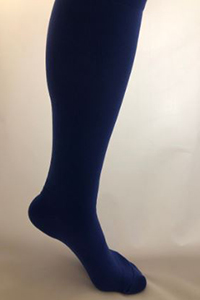
If you compare XXL compression stockings to regular sizes, you will generally find that they are made of thicker, stretchier fabrics.
Thin textiles, such as microfiber, cannot adequately support large leg muscles. Moreover, medical stockings made of sheer cloth are more prone to running and tearing than other fabrics.
What fabrics are most suitable then? Wearers with large legs find that medical hosiery made of opaque or sports material lasts longer and is the most comfortable.
They’re also designed to be temperature and moisture resistant, so they don’t need to be changed as frequently as sheer styles.
The best medical hosiery will be made from sturdy, stretchy cloth that feels airy and breathable when worn. Finding high-quality, medical-grade material is as important as finding the right size stockings for your legs.
If I Have Large Legs, Can I Use Knee- or Thigh-highs?
Yes! If your legs are larger than average for one reason or another, XXL compression stockings will be your saving grace. Athletes with thick leg muscles depend on extra-large sizes to support their legs and improve circulation.
Since XXL sizes are designed for large legs, you can wear whatever style available in your size. (Don’t forget to measure!)
Even if your legs are usually of average proportions, severe swelling can cause them to increase in circumference. You may need to temporarily wear XXL hosiery or socks until your legs return to normal.
Certain injuries, such as a sprain, may cause one leg to swell while the other remains unaffected. In these cases, you may want to wear an XXL compression sock on the injured leg and a smaller size on the uninjured limb until you recover.
Sometimes, people with wide calves use medical hosiery or socks with zippers as an alternative to traditional styles in larger sizes. However, these socks are not as readily available.
They can also be quite tricky to take on and off, making them a poor choice for older adults. Whether it’s large or small, always be sure to wear the right size of knee- or thigh-highs.
How Do I Put On My Compression Socks?
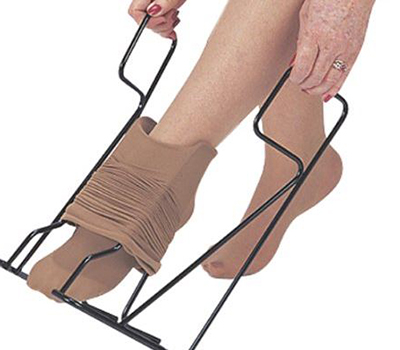
The unique shape and build of large legs may make it difficult to put on and take off stretchy medical stockings. Rather than struggle, consider buying stockings with silicone-top bands.
The silicone helps hold hosiery in place, preventing them from sliding or rolling down. Compression socks with silicone-top bands are especially helpful for those whose legs are wide beneath the knee.
After using banded compression socks, check to see if there are any red marks on the back of your knees. If you see indented lines and creases, the bands of your compression socks are digging into the back of your knees and the band is too tight. Switch to a better fit!
If you are using knee-high compression socks, make sure not to overstretch them further than the bottom of your kneecap. Stretching them above your knees may damage your sock so that you can’t benefit fully from their compression.
In the case of thigh-high compression socks, they should be worn just below your buttocks.
Your compression socks shouldn’t cause any pain or discomfort.
Most people dismiss such symptoms as natural side-effects of using compression socks. However, the fact is that compression socks should never make you uncomfortable.
After all, your compression socks are supposed to provide relief and support. If you feel pain or discomfort, it is probably because your compression socks are too small or the compression level is too high.
Don’t ignore adverse side effects. Stop wearing your socks until you figure out what’s causing the problem. In the case of prescription socks, consult a medical professional for an adjustment.
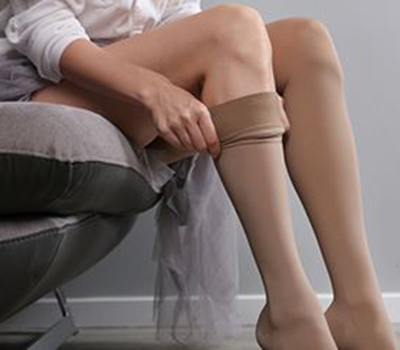
Popular Articles on ComproGear
Compression Socks for Men Men’s Circulation Socks
How Long To Wear Compression Socks for Edema Review of Stockings for Edema
Best Compression Socks for Sitting All Day Swollen Ankles After Sitting Desk All Day
Compression Socks for Swollen Feet Stop Varicose Veins in Legs and Feet
How Do I Take Care of My Large Compression Socks?
Once you invest in a pair of large medical hoses, you want to keep them in good condition for as long as possible.
Here are some tips to ensure that they last:
- Always wash your compression socks by hand in cold water. Using washing machines or hot water may reduce the elasticity of your compression socks in the long run. Compression hosiery may be damaged and get runs in the spin cycle.
- The gentlest method to remove water from the compression socks is to squeeze out the water with a towel. Don’t wring them.
- Do not expose your compression socks to direct heat, such as by using a dryer. Excessive heat will ruin the fabric and reduce the stretchiness of your compression socks.
- After washing the compression socks, hang them in the shade to dry. Direct sunlight might lead to fabric damage and fading.
- Do not expose your compression socks to excessive moisture, except for washing. You shouldn’t wear them while bathing or showering.
- The longer you wear compression socks, the looser they become. Generally, washing can restore the elastic properties of compression socks. However, after about six months or so of frequent wear, compression socks can lose their elasticity completely and become like regular socks. Therefore, plan on replacing your compression socks at least once every six months.
The Take-Home Message about Support Footwear
Though choosing the right size and style of XXL compression stockings may seem like a challenge at first, with this helpful information, you can find the perfect pair for you. Gather all your measurements, consult a doctor if necessary, and buy with confidence!
This page last updated November 5, 2022
